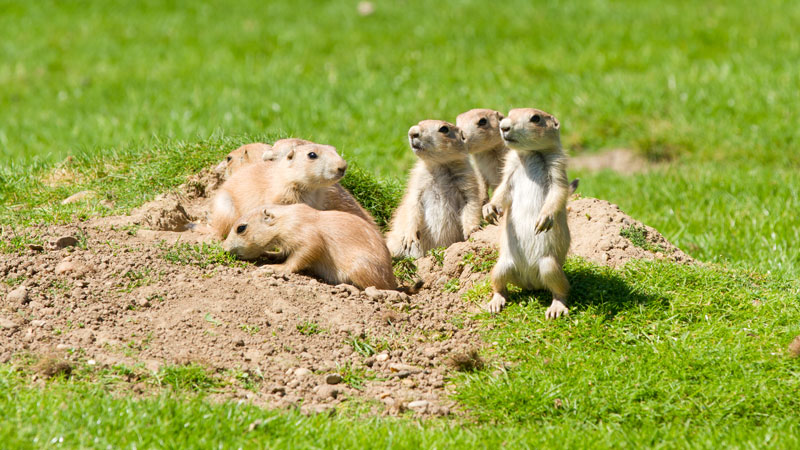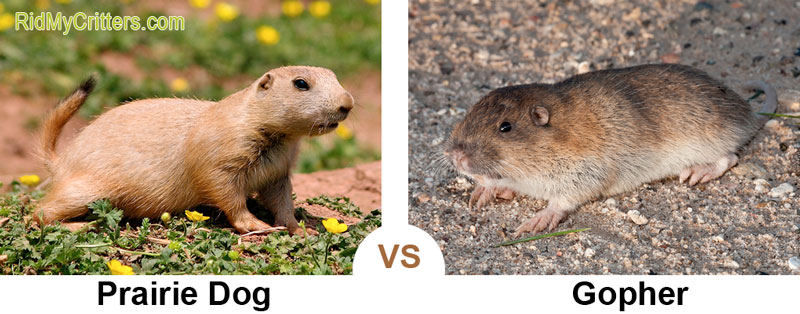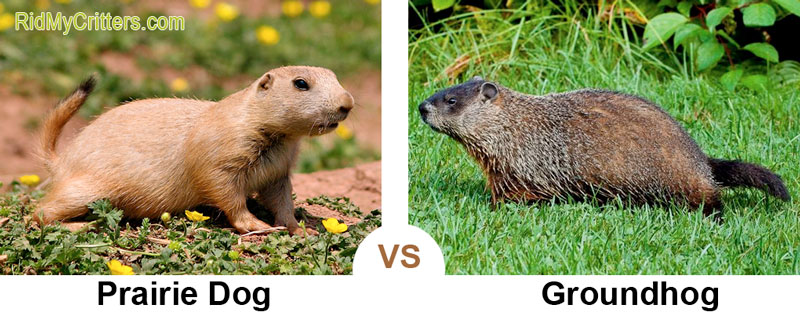Certainly one of the cuter species of rodent, prairie dogs are a communal critter consisting of five species. As with most rodents, they’re quite intelligent but inadvertently destructive, making it necessary to get rid of prairie dogs which find their way onto your property.
The good news is that dealing with a prairie dog infestation isn’t always difficult. The bad news is that they behave a lot like meerkats (as you can see from the photo above), making it harder to sneak up on prairie dog colonies.
Let’s take a deeper dive into these curious critters to find their strengths and weaknesses, then move on to getting rid of them.
Getting to Know Prairie Dogs
Just like with all other critters, the more you know about prairie dogs, the easier it is to deal with them. As prairie dogs are very aware of their surroundings, simply sticking a trap nearby won’t be enough. Instead, you’ll have to learn their weaknesses and exploit them to ensure these critters leave your property and stay away.
Unlike most other common rodent invaders, these critters tend to be vocal. They got their name because a prairie dog sounds like a small dog when warning of predators or doing mating calls. This can often be the first sign you’ll get that a group are eyeing your property as potential real estate.
What do Prairie Dogs Eat?
Prairie dogs live mostly on grasses and roots, but will also eat fruits, seeds, grains, and even insects when they’re available. This makes them an absolute terror when loose in your garden or front lawn. Despite having lost up to 98 percent of their habitat, the efficient breeding habits of prairie dogs (they make rabbits look celibate!) means an invasion onto your property can be one tough fight for survival.
Home and Habitat
Once found throughout the entire midwest, prairie dogs have been in a rapid state of decline, leaving them in about 11 states and one province in Canada. They’re highly social, burrowing deep underground into small communities.
Prairie dog burrows can be identified from a tall-ridged crater at the entrance. These entrances are designed to prevent flooding in a heavy rain, but are easy to spot. It also doubles as a sentry post.
Underground, the entrance becomes a complex network of tunnels and rooms. The burrow (if you’re lucky) may consist of one family known as a cotery. Multiple coteries, known as a ward, may cohabitate together. In a worst case scenario, you may be facing a full colony (several wards) that could potentially contain thousands of prairie dog adults and pups.
Mating season starts in March, and up to eight pups will be born around late April or May. This makes it extremely important to get any prairie dogs out before spring, as the population can easily grow out of control and devastate your garden or lawn.
Identifying Your Prairie Dog
As mentioned, there are five different species of prairie dog, and knowing which one you’re dealing with can greatly affect the methods for getting rid of them. These rodents have lost the vast majority of their natural habitat, but their social structure and ability to quickly replenish a population means that most species aren’t currently on watch lists.
Black-Tailed Prairie Dog

As the name implies, these critters are easily identified by the black tip on their tail. The marking somewhat makes them look as though they dipped their tails in ink. As of 2009, this species was reviewed and deemed healthy enough to exclude them from endangered lists.
Gunnison’s Prairie Dog

This species has yellowish buff fur mixed with black and a white-tipped tail. While denied endangered status in 2014, it should be noted that this is an extremely important keystone species in their native habitat and should thus still be treated with some level of care. You can find Gunnison’s prairie dogs in the four-corners region of Arizona, Colorado, New Mexico, and Utah.
Mexican Prairie Dog

With reddish-brown fur and a lighter underbelly, Mexican prairie dogs can be easier to identify than other species. They have a black tail tip which covers nearly half the tail, unlike the black-tipped species. This species is currently on the endangered list and should be treated with care.
Utah Prairie Dog

The most striking feature of these cinnamon to clay colored critters are the dark eyebrows which give them an almost comical appearance. They have white tips on their tails and are currently on the endangered species list.
White-Tailed Prairie Dog

These tannish-brown pelted critters have darker brown streaks reaching from above the eyes down the cheeks and a short, white-tipped tail. A survey of the species in 2010 deemed it as non-endangered.
Prairie Dog vs Gopher
While the two rodents may seem alike at first glance, certain behaviors can help you distinguish which you have on your property. For example, prairie dogs are highly social animals and breed annually, whereas gophers are solitary and breed all year around.
The entrance to a gopher’s burrow will be plugged, but prairie dogs keep the door open. You are also much more likely to see a prairie dog eating in the yard, since gophers pull their food underground to eat in the safety of their burrow.
Prairie Dog vs Groundhog
Groundhogs grow to be up to twice the size of a prairie dog. They also live in much smaller groups, with burrows shared by only three or four individuals that use it primarily for hibernation and avoiding predators. Prairie dogs, meanwhile, will almost always have a sentry posted outside of the burrow.
How to Get Rid of Prairie Dogs
Due to their highly social nature, spotting one prairie dog means you’re likely dealing with a whole colony. They can be a nightmare to get rid of, as they multiple quickly and older prairie dogs will actively avoid traps. Thankfully, there are ways to reduce the population and, ultimately, get them to leave your property.
See Also: How to Get Rid of Squirrels
From a Field
This can be the toughest scenario to solve, as prairie dogs will have plenty of roots and tall grass to gnaw on. You can uproot any plants that may provide root food and keep the grasses short in combination with traps and repellent, but this can be a slow and frustrating process.
Alternatively, you can rototill the entire field, leveling it out with a tractor blade or performing a controlled burning to eliminate food and discourage burrowing. This can be a lengthy process, with a wait of up to two years before it’s wise to plant crops. However, the remedy can do a good job of evicting even large colonies.
From the Shed
Sheds are one of the few places traps will actually work well against prairie dogs. Once you know how to trap a prairie dog in an enclosed space, they can become desperate enough to enter baited traps for food.
As you’ll be working with a very small population, we suggest a good no-kill trap, such as the Havahart 1089. Ensure there are no easy escape routes from the shed and set your traps.
Keep the shed locked so family members won’t accidentally let the critters out and check periodically for successful captures. Be sure to relocate the prairie dogs soon after capture.
From the Yard
Prairie dogs can decimate a well-manicured lawn quickly, leaving an expensive repair job behind. Unfortunately, the only way to really get rid of them is through flooding the den. Most of the prairie dogs will escape, but a few will likely drown. Always be sure to identify the species before attempting this method.
You can also use a prairie dog repellent (such as predator urine) near burrow entrances to help encourage the critters to vacate your lawn, but this works best when you have a very small group of prairie dogs and can locate most of the burrow entrances.
Filling in their burrowing holes may also convince them to move away from your yard and eventually lets them know they’re not welcome.
From Your Garden
This can be a worst-case scenario, as prairie dogs will devour the roots and many of your fruits and vegetables. A fence is the best option, but you will have to do some digging. Your fence should extend a few feet below ground so the prairie dogs can’t burrow below it, as well as a couple feet above ground.
In the event you already have prairie dogs in your garden, you may need to leave a small temporary opening and flood the burrow to evict those trapped within the garden enclosure.
How to Kill Prairie Dogs
While we never condone the killing of beneficial critters, it’s not uncommon to see people killing these critters. Always be sure you’re not dealing with an endangered species before attempting any of these methods.
Kill Traps
Kill traps are a mixed bag. Not only will it require the same effort to place as a no-kill trap, you also run the risk of harming other critters. Worst of all, you’re likely to only kill a few pups, which will be quickly be replaced. Thus, this is an alternative best avoided.
Prairie Dog Poison
Poisons should never be used unless there’s no alternative, as other critters can fall prey to poisoned bait. This can be especially true with prairie dogs, as it can take days of baiting before you can lay out poison.
During that time, other critters may start taking the bait as well. The following is a popular poison method for dealing with these rodents:
- Spread a heaping tablespoon of rolled oats around each prairie dog hole.
- Add another tablespoon every day until the prairie dogs begin eating it readily.
- Add a toxin (zinc phosphide, for example) to the oats as you continue baiting.
- Remove any corpses as soon as you spot them to avoid attracting (and harming) predator critters.
Shooting
While ill-advised for urban and rural homes, many country homesteaders actively shoot prairie dogs as a means of population control. This method has limited effect against the population, which can quickly recover from mild to moderate losses.
The Great Smoke Dilemma
As we’ve mentioned before, prairie dog burrows have multiple entrances and extend several feet deep. It can be really difficult to chase an entire colony of prairie dogs from the burrow because they can simply use another entrance when you’re not looking.
Colored Smoke
It’s possible to use a popular home improvement trick to try and locate the burrow entrances, but this can be risky. You’ll have to find one of the entrances, then pump colored smoke into the hole. The method is popular when checking homes for entry points and other tiny holes.
When it comes to the burrows, the smoke will theoretically create small plumes where other entrances are located, allowing you to mark them. However, it’s also possible for the smoke to escape through tiny ground fissures if it hasn’t rained in a while. Even worse, some prairie dogs may get trapped and suffocate.
It’s best to consult with a pest control expert and see if colored smoke testing is available before attempting this trick yourself.
Smoke Bombs
There are a number of rodent bombs out there that work similarly to a bed bug or spider bomb. The problem is that these are highly toxic and may kill beneficial critters when they’re activated. Unlike pumping a bit of colored smoke into the burrow, these bombs are designed to kill and do a good job of it.
We suggest you read this documentation for the recently approved Revenge Rodent Smoke Bomb for an idea of just how dangerous these bombs can be. The document also details proper use and other important details, making it a great way to evaluate if using a rodent bomb is right for you.
- How to Get Rid of Hawks - March 8, 2024
- How to Get Rid of Pill Bugs (Rolly Pollies) - March 1, 2024
- How to Get Rid of Groundhogs (Woodchucks) - February 5, 2024



 Just tell me how to get rid of ’em.
Just tell me how to get rid of ’em.

I found your web site very informative and to the point. This in it self is a huge time saver so thank you for that. I will be trying a number if your suggestions and will share what was successful also what wasn’t. Thank you so much for giving me choices that I as comfortable with. I’ll keep in touch. Thanks, Sue
Thanks Sue!
Has anyone tried using exhaust gas (carbon monoxide) to get rid of a small prairie dog colony?
I always thought noises would chase prairie dogs off, but that is not the case. I have a bunch of them living on the shoulder of the road by my house. It is heavily traveled by gravel trucks, cement trucks and semis … they don’t seem to mind. Will planting a thick blanket of creeping thyme help to discourage them? I was going to use mini white Dutch clover, but they like that. I am going to plant that in yard because of grass allergies, but I do not want to lay out the welcome mat. Just looking for something to keep down weeds, low maintenance and that they are not fond of.
I used to like them, now my backyard is under attack and I can’t seem to get rid of them. Sometimes I let my cat go out and scare them
When I clean the cat litter box and put the poo in plastic bags I started dropping one at a time in each prairie dog hole and then covering it with rocks. We had quite a number in a grassy area and now we have none, so I’ll always think the disgusting litter chased them away!
Will coffee grounds help get rid of this rodent?
While coffee grounds may help repel some insects, they probably won’t do anything against prairie dogs.
My Aunt planted some nice bushes in her front yard along with some misquit trees. Bushes are pretty much gone but not the trees. She is having awful time getting rid of these prarie dogs. Does anyone know if putting horse manure or urine down the holes will deter them from coming back ? She has horses and seems that there are no holes in the main area where they relieve themselves at. Just wondering. Thanks
I have tried peppermint oil & water in a spry unit but it did not seem to hold them back very long. I’ve lost a thousand dollars in plants and had to stop feeding my wild birds because the Prairie Dog population exploded doing so.
I’ve never had prairie dogs till 2 years ago. I spent a lot of time last year covering holes, feeding them bubble gum, and a stinky brew of lemon juice, white vinegar, chopped onion, cayenne pepper, and chili powder. It took about 3 weeks, but it worked they stayed away from my back field. This year, I got a single annoying fur ball that doesn’t seem to like tall grass. So I’m going to let the far end of the field grow this year and see how that works.
our lawn is under attack but there are no holes but mounds of dirt. The city of Calgary will not do anything because it is our yard in the city. So even when you pay property tax it is still our problem. if anyone has any ideas we could use some ideas?
Would mothballs work? To kill or run them off.
Anyone have any ideas how to get one out of a house? Don’t ask me how it got in there but it is actively destroying my disabled fathers house and he hides in the attic and I have no idea how to get in there. He comes down through the ceiling he’s destroyed and has literally taken all his food out of his pantry, managed to get food and escape a live trap, and now he is getting on the fridge somehow. He’s even gotten brave enough to come in the dining room where he has totes and is digging through them looking for food. I have no idea how to help him any ideas? He has a prosthetic leg so when he hears it it takes him a bit to get up to try to even do anything And by the time he gets in the other room this thing has hidden again.
Has he tried calling animal control in his area?
They may come out, if not, maybe try DOW ( Department of Wildlife)
Good Luck!
since solar panels have been put in outside my back fence near I-25 the prairie dogs have moved in. my yard isn’t large but I have 5 large prairie dog holes. I can’t plant anything. they destroy it all.
Has anyone tried castor oil? I’ve read about it being a deterrent for Gophers but don’t know about Prairie Dogs?